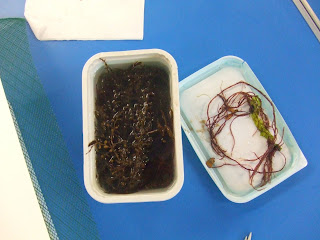Today I went to a workshop to learn how to press seaweed. What fun! It turns out that it is just like pressing flowers except that you press it wet. The tutor showed us a 'Seaweed Diary' that she had made - a page for each month, showing how the varieties change throughout the year.
We started by donning wellies and going down onto the beach at Lepe Country Park to collect seaweed in a margarine tub. We were advised not to pick anything too fleshy, like Bladderwrack, as it would just go mouldy in the press.
When we got back to the classroom we were given a shallow tray with a piece of plastic mesh over the top. I reckon you could use any plastic tray and something like a cake rack as all it was doing was supporting the paper and letting the water drip into the tray.
We squirted sea water onto thick quality (300gsm) watercolour paper and then placed our seaweed sample on. We used thin knitting needles, the kind you use to knit socks, to spread out all the fronds into a natural looking arrangement.
This was super-fiddly and required a lot of patience - right up my street! I love the way they look and was so pleased to learn how to do this.
The tutor said that you can fiddle about with the seaweed out of water for up to an hour and then it will start degrading.
This was my first sheet of samples - a bit of a red theme going on.
Then I did this page. The green frondy one at 4 o'clock took ages and I fear that the red spidery one at 6 o'clock might disintegrate in the press - we were warned that this can happen if they are too delicate.
You can use a pipette of water to help float the fronds out into a nice arrangement but you have to tip all the water off the page at the end before it goes into the press, so it can all float back again!
The paper at the back is the paper that your samples will be on forever so we tried not to get it dirty and to position our samples carefully.
Finally into the press. This is just like a flower press but bigger. She put blotting paper between each page of seaweed and will put more on top at the end.
It takes 6 weeks to dry out in the press so I have to go back then to pick up my pages and see if they still look as good when dried.
Below are a few of the beautiful dried and framed specimens she brought in to show us. These were quite big and must have taken ages to do.
Finally, a bit of Olympic textiles. This is an installation at the Great Hall in Winchester made by children inspired by the Olympic Rings. It is mostly wool wrapped rings fastened onto mesh. It is very colourful but most impressive is the scale - 3 big panels like this.






